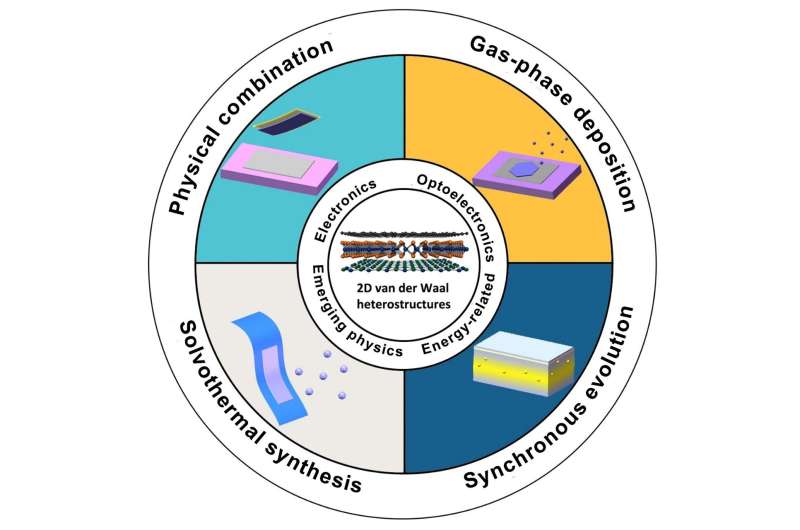This article has been reviewed according to Science X's editorial process and policies. Editors have highlighted the following attributes while ensuring the content's credibility:
fact-checked
proofread
Fabrication and applications of van der Waals heterostructures

The explosion of two-dimensional layered materials (2DLMs) with various unique properties provides basic building blocks for van der Waals heterostructures (vdWHs). The vdWHs integrated with various stacking alignments of 2DLMs exhibit many promising functionalities in diverse fields, including electronics, optoelectronics, thermoelectrics, sensing and energy conversion and storage. In addition, the accompanying novel physical phenomena in vdWHs make vdWHs a perfect platform for exploring condensed matter physics, especially in low-dimensional domains.
To meet the demands in different fields, many strategies for the fabrication of vdWHs have been developed in the past decade. The vdWHs obtained by different fabricating strategies differ in key properties, such as layer number, cleanliness, defect density, and interface uniformity, which determine their application performance.
Publishing in the journal International Journal of Extreme Manufacturing, the team led by researchers based at the City University of Hongkong have summarized the current state of development in the fabrication and applications of vdWHs to facilitate more rational designs of vdWHs for deeper exploration of the low-dimensional world.
The team introduced the mechanism and process of major strategies to fabricate vdWHs, and compared the key characteristics of vdWHs prepared via different methods. Then, the potential applications of vdWHs in electronics, optoelectronics, as well as energy conversion and storage were demonstrated. The moiré superlattices based on resonant emissions as representatives of emerging novel physical phenomena were also illustrated. Finally, challenges and potential opportunities of fabrications and applications of vdWHs were outlined.
The director of the research team, HE Qiyuan, said "It is no exaggeration to say that the emergence of two-dimensional materials has provided us with a new avenue for further exploration of the world. With the exploration of 2D materials, researchers have begun to work on modulating and optimizing the properties and performance of 2D materials to meet the requirements of different practical applications. Integrating various 2D materials into vdWHs is one of the most promising strategies."
"VdWHs not only greatly enrich the 2D-material library but also are accompanied by numerous novel and unique physical phenomena and properties, such as moiré patterns, synergistic effect, fractal quantum hall effect, and resonant tunneling phenomenon, making vdWHs an excellent platform for studying condensed matter physics. Furthermore, the design idea of vdWHs is practically not limited to 2D materials, and it also shows great potential in collocations of materials in varying dimensions, including 0D, 1D, 2D and 3D. This opens up opportunities to construct comprehensive and coherent full-dimensional physical models."
Thus, there is an urgent need to develop universal and controllable fabrication methods for vdWHs. This review discusses the state of the art of vdWHs fabrication, and the major strategies are categorized into four classes: physical combination, gas-phase deposition, solvothermal synthesis and synchronous evolution.
Co-first author Ph.D. student QI Junlei said, "The vdWHs obtained by various fabrication methods have advantages and disadvantages regarding their characteristics and performance. Therefore, choosing suitable synthetic methods in different application fields is particularly crucial."
This review illustrated the integration design based on the vdWHs in electronics, photodetectors and energy-related applications. In addition, it discussed the fundamental research on novel physical phenomena represented by moiré superlattice. Combined with the application examples, it can be proved that the suitable applications of vdWHs obtained by different synthesis methods are pretty different.
For example, relatively controllable mechanical assemblies are ideal for studying physical phenomena which require high-quality interfaces. Meanwhile, solvothermal methods with high yields and multiple active sites are more suitable for applications such as catalysis and energy storage.
Dr. He said, "Remarkable progress has been made in the fabrication and applications of vdWHs in the past decade, but our excavation of vdWHs is still the tip of the iceberg. On the one hand, a general synthetic method for the scalable and controllable preparation of vdWHs by design has not yet been realized, and the contradiction between high quality and high yield remains unresolved."
"Although challenges are ubiquitous, the performance of devices based on vdWHs has surpassed many traditional materials. They can be used to reveal and study physical phenomena that conventional methods could not realize. It is undeniable that vdWHs have become a force to be reckoned with in multidisciplinary research and multifield applications."
More information: Junlei Qi et al, Fabrication and applications of van der Waals heterostructures, International Journal of Extreme Manufacturing (2023). DOI: 10.1088/2631-7990/acc8a1
Provided by International Journal of Extreme Manufacturing





















